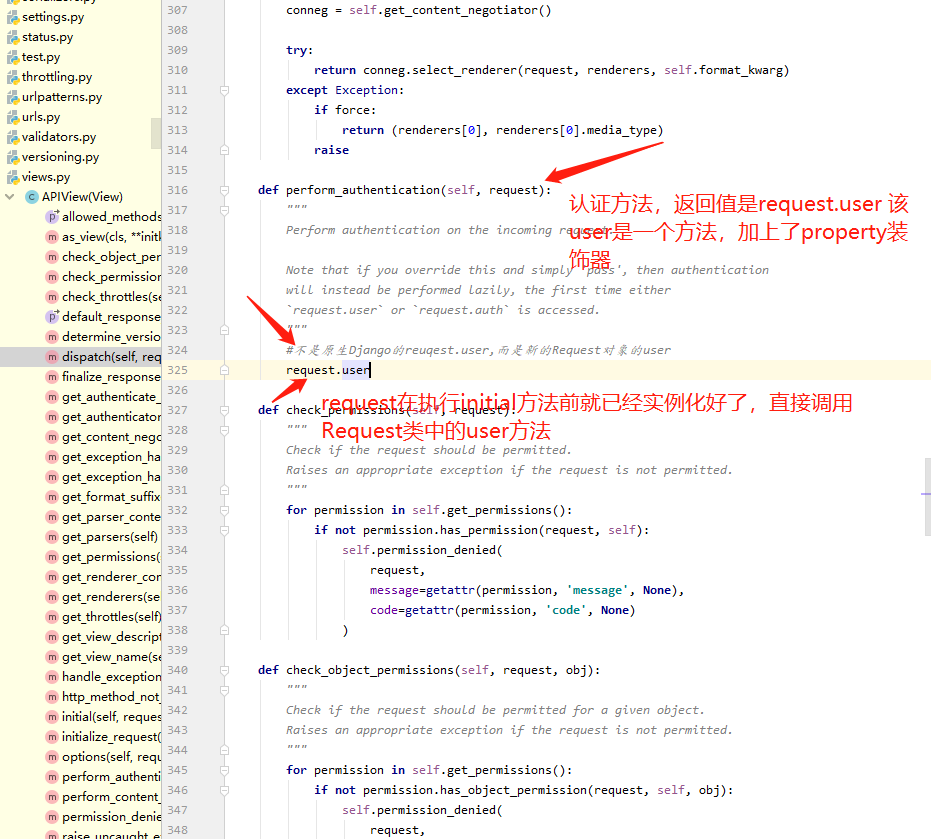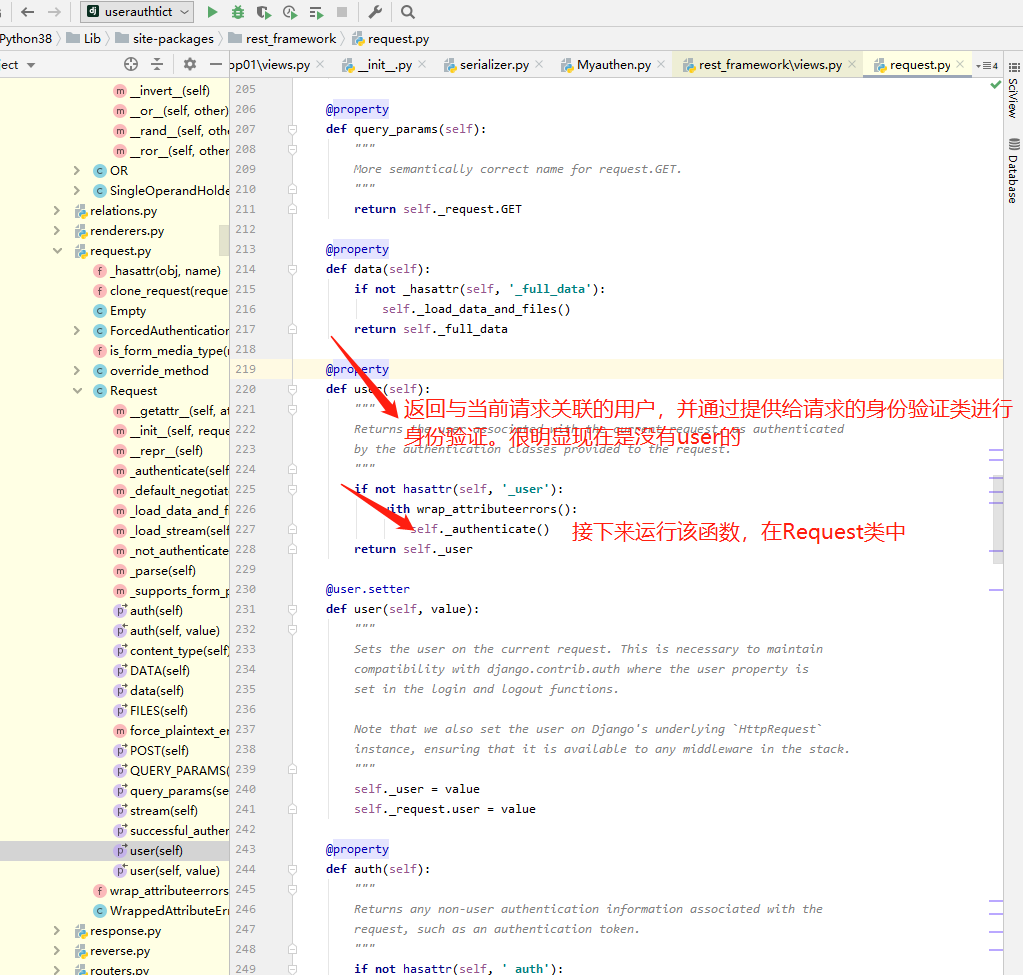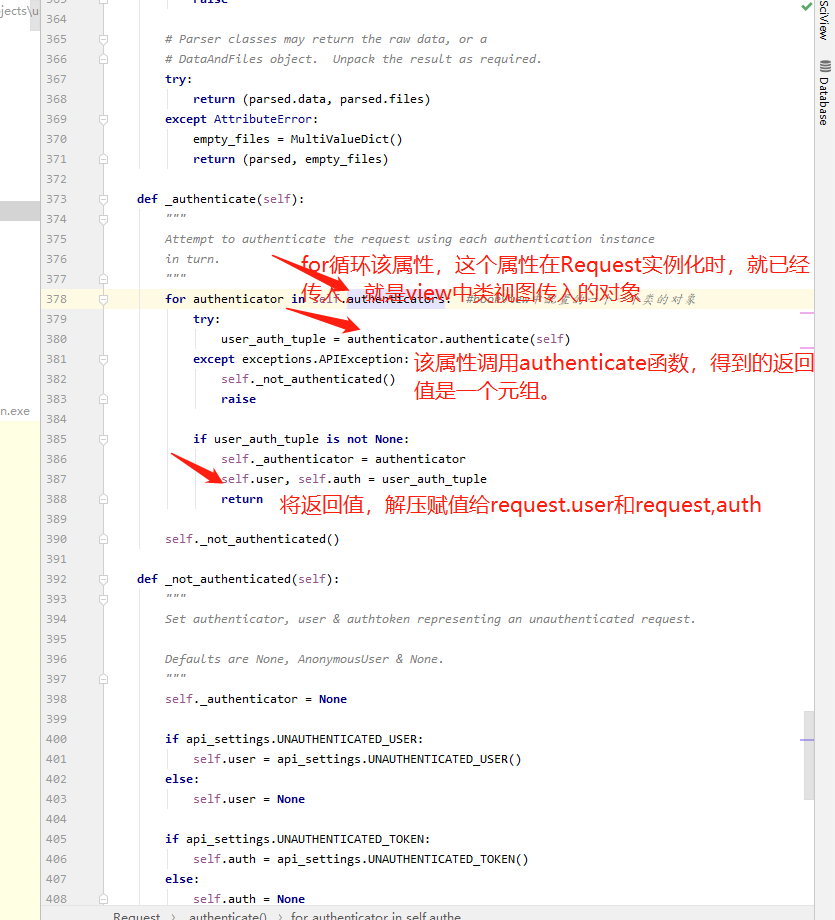drf认证功能,认证功能源码分析 自定义认证类 认证功能布局使用和全局使用 自定义权限功能 权限功能局部使用和全局使用 内置的权限和认证类
一、drf认证功能介绍
1 认证、频率、权限 2 用户是否登录到系统中 3 后期基本上会用JWT的认证 4 自定制的认证
二、认证功能源码分析
1、APIView--->dispatch--->self.initial(request,*args,**kwargs)----> self.perform_authentication(request)--->Request.user--->self._authenticate(self):Request类的方法
--->self.authenticators:Request类的属性---》在Request对象实例化的时候传入的--->Request在什么时候实例化?dispatch的时候--
---》APIView:self.get_authenticators()-->return [auth() for auth in self.authentication_classes]--->如果在自己定义
的视图类中写了authentication_classes=[类2,类2]-->Request的self.authenticators就变成了我们配置的一个个类的对象
源码分析
2 self._authenticate(self):Request类的方法
def _authenticate(sel):
for authenticator in self.authenticators: #BookView中配置的一个个类的对象
try:
user_auth_tuple = authenticator.authenticate(self)
except exceptions.APIException:
self._not_authenticated()
raise
if user_auth_tuple is not None:
self._authenticator = authenticator
self.user,self.auth = user_auth_tuple
return
3只要在视图类中配置authentication_classes = [MyAuthen.LoginAuth, ]
就会执行上面的方法,执行认证
在源码中的执行流程
运行到APIView中的dispatch

执行dispatch中的initial

执行认证函数

在认证函数中,执行request.user

在Reuqest类中执行self._authenticate()

接下来2张图是Request在实例化时所作的事情


3 自定义认证类(重点)
1 使用 定义一个类,继承BaseAuthentication
class LoginAuth(BaseAuthentication): def authenticate(self,request): token = request.GET.get('token') res = models.UserToken.objects.filter(token=token).first()
if res:
return 元组 ()返回的元组有什么意义
else:
raise AuthenticationFailed('您没有登录')
重写authenticate方法
局部使用和全局使用
局部:
在视图类中配置(只要配置了,就是登录后才可以访问,没配置,不用登录就能访问)
authentication_classes = [MyAuthen.LoginAuth,]
全局:
REST_FRAMWORK = {'DEFAULT_AUTHENTICATION_CLASSES':['app01.MyAuthen.LoginAuth'],}
注意:
1 认证类,认证可以通过可以返回一个元组,有两个值,第一个值会给,request.user,第二个值会给request.auth
2认证类可以配置多个,按照从前往后的顺序执行,如果前面有返回值,认证就不再继续往下走了
4 认证功能局部使用和全局使用
1 全局使用(所有接口,都需要登录后才能访问) 在配置文件中: REST_FRAMEWORK = { "DEFAULT_AUTHENTICATION_CLASSES": ["app01.MyAuthen.LoginAuth", ] } 2 局部使用 -在想局部使用的视图类上 authentication_classes = [MyAuthen.LoginAuth,] 3 局部禁用 -在想禁用的视图类上 authentication_classes = []
5 自定义权限功能(重点)
1 登录成功后,超级用户可以干某些事,普通用户不能干-->超级用户可以查看 某些接口,普通用户不能查看 2 使用写一个类继承BasePermission,重写has_permission class SuperPermission(BasePermission): def has_permission(self,request,view): # Return `True` if permission is granted, `False` otherwise. # 超级用户可以访问,除了超级用户以外,都不能访问 if request.user.user_type == '1': return True else: return False 3 局部使用和全局使用 -在想局部使用的视图类上 permission_classes = [MyAuthen.SuperPermission] -全局使用 REST_FRAMEWORK = { "DEFAULT_PERMISSION_CLASSES": ["app01.MyAuthen.SuperPermission", ] } -局部禁用 permission_classes = []
6 权限功能局部使用和全局使用
1 使用方式 -在想局部使用的视图类上 permission_classes = [MyAuthen.SuperPermission] -全局使用 REST_FRAMEWORK = { "DEFAULT_PERMISSION_CLASSES": ["app01.MyAuthen.SuperPermission", ] } -局部禁用 permission_classes = []
# 内置认证类 from rest_framework.exceptions import AuthenticationFailed # 内置权限类 from rest_framework.permissions import BasePermission
拓展
1 select_related的使用 articleList=models.Article.objects.select_related("category").all() for article_obj in articleList: # Doesn't hit the database, because article_obj.category # has been prepopulated in the previous query. #不再查询数据库,因为第一次查询,数据已经填充进去了 print(article_obj.category.title) 2 mysql的悲观锁和乐观锁 3 drf内部内置了一些认证类,分别干了什么事